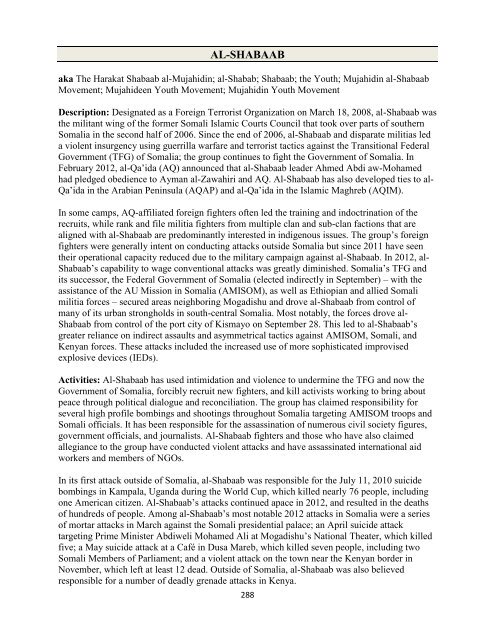Country Reports on Terrorism 2012
Country Reports on Terrorism 2012
Country Reports on Terrorism 2012
You also want an ePaper? Increase the reach of your titles
YUMPU automatically turns print PDFs into web optimized ePapers that Google loves.
AL-SHABAAB<br />
aka The Harakat Shabaab al-Mujahidin; al-Shabab; Shabaab; the Youth; Mujahidin al-Shabaab<br />
Movement; Mujahideen Youth Movement; Mujahidin Youth Movement<br />
Descripti<strong>on</strong>: Designated as a Foreign Terrorist Organizati<strong>on</strong> <strong>on</strong> March 18, 2008, al-Shabaab was<br />
the militant wing of the former Somali Islamic Courts Council that took over parts of southern<br />
Somalia in the sec<strong>on</strong>d half of 2006. Since the end of 2006, al-Shabaab and disparate militias led<br />
a violent insurgency using guerrilla warfare and terrorist tactics against the Transiti<strong>on</strong>al Federal<br />
Government (TFG) of Somalia; the group c<strong>on</strong>tinues to fight the Government of Somalia. In<br />
February <strong>2012</strong>, al-Qa’ida (AQ) announced that al-Shabaab leader Ahmed Abdi aw-Mohamed<br />
had pledged obedience to Ayman al-Zawahiri and AQ. Al-Shabaab has also developed ties to al-<br />
Qa’ida in the Arabian Peninsula (AQAP) and al-Qa’ida in the Islamic Maghreb (AQIM).<br />
In some camps, AQ-affiliated foreign fighters often led the training and indoctrinati<strong>on</strong> of the<br />
recruits, while rank and file militia fighters from multiple clan and sub-clan facti<strong>on</strong>s that are<br />
aligned with al-Shabaab are predominantly interested in indigenous issues. The group’s foreign<br />
fighters were generally intent <strong>on</strong> c<strong>on</strong>ducting attacks outside Somalia but since 2011 have seen<br />
their operati<strong>on</strong>al capacity reduced due to the military campaign against al-Shabaab. In <strong>2012</strong>, al-<br />
Shabaab’s capability to wage c<strong>on</strong>venti<strong>on</strong>al attacks was greatly diminished. Somalia’s TFG and<br />
its successor, the Federal Government of Somalia (elected indirectly in September) – with the<br />
assistance of the AU Missi<strong>on</strong> in Somalia (AMISOM), as well as Ethiopian and allied Somali<br />
militia forces – secured areas neighboring Mogadishu and drove al-Shabaab from c<strong>on</strong>trol of<br />
many of its urban str<strong>on</strong>gholds in south-central Somalia. Most notably, the forces drove al-<br />
Shabaab from c<strong>on</strong>trol of the port city of Kismayo <strong>on</strong> September 28. This led to al-Shabaab’s<br />
greater reliance <strong>on</strong> indirect assaults and asymmetrical tactics against AMISOM, Somali, and<br />
Kenyan forces. These attacks included the increased use of more sophisticated improvised<br />
explosive devices (IEDs).<br />
Activities: Al-Shabaab has used intimidati<strong>on</strong> and violence to undermine the TFG and now the<br />
Government of Somalia, forcibly recruit new fighters, and kill activists working to bring about<br />
peace through political dialogue and rec<strong>on</strong>ciliati<strong>on</strong>. The group has claimed resp<strong>on</strong>sibility for<br />
several high profile bombings and shootings throughout Somalia targeting AMISOM troops and<br />
Somali officials. It has been resp<strong>on</strong>sible for the assassinati<strong>on</strong> of numerous civil society figures,<br />
government officials, and journalists. Al-Shabaab fighters and those who have also claimed<br />
allegiance to the group have c<strong>on</strong>ducted violent attacks and have assassinated internati<strong>on</strong>al aid<br />
workers and members of NGOs.<br />
In its first attack outside of Somalia, al-Shabaab was resp<strong>on</strong>sible for the July 11, 2010 suicide<br />
bombings in Kampala, Uganda during the World Cup, which killed nearly 76 people, including<br />
<strong>on</strong>e American citizen. Al-Shabaab’s attacks c<strong>on</strong>tinued apace in <strong>2012</strong>, and resulted in the deaths<br />
of hundreds of people. Am<strong>on</strong>g al-Shabaab’s most notable <strong>2012</strong> attacks in Somalia were a series<br />
of mortar attacks in March against the Somali presidential palace; an April suicide attack<br />
targeting Prime Minister Abdiweli Mohamed Ali at Mogadishu’s Nati<strong>on</strong>al Theater, which killed<br />
five; a May suicide attack at a Café in Dusa Mareb, which killed seven people, including two<br />
Somali Members of Parliament; and a violent attack <strong>on</strong> the town near the Kenyan border in<br />
November, which left at least 12 dead. Outside of Somalia, al-Shabaab was also believed<br />
resp<strong>on</strong>sible for a number of deadly grenade attacks in Kenya.<br />
288









